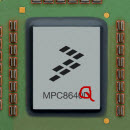![]() I just spotted a fun little application on Freescale’s homepage: an interactive demo of the fault tolerance functions of the MPC564XL dual-core microcontroller.
I just spotted a fun little application on Freescale’s homepage: an interactive demo of the fault tolerance functions of the MPC564XL dual-core microcontroller.
Tag: freescale
Freescale P4080, in Physical Form
![]() Past Tuesday, I attended the Freescale Design With Freescale (DWF) one-day technology event in Kista, Stockholm. This is a small-scale version of the big Freescale Technology Forum, and featured four tracks of talks running from the morning into the afternoon. All very technical, aimed at designing engineers.
Past Tuesday, I attended the Freescale Design With Freescale (DWF) one-day technology event in Kista, Stockholm. This is a small-scale version of the big Freescale Technology Forum, and featured four tracks of talks running from the morning into the afternoon. All very technical, aimed at designing engineers.
Downloadable Book about Embedded Multicore
![]() Freescale has now released the collected, updated, and restyled book version of the article series on embedded multicore that I wrote last year together with Patrik Strömblad of Enea, and Jonas Svennebring, and John Logan of Freescale. The book covers the basics of multicore software and hardware, as well as operating systems issues and virtual platforms. Obviously, the virtual platform part was my contribution.
Freescale has now released the collected, updated, and restyled book version of the article series on embedded multicore that I wrote last year together with Patrik Strömblad of Enea, and Jonas Svennebring, and John Logan of Freescale. The book covers the basics of multicore software and hardware, as well as operating systems issues and virtual platforms. Obviously, the virtual platform part was my contribution.
Continue reading “Downloadable Book about Embedded Multicore”
EETimes.com – Multicore CPUs face slow road in comms
 The EETimes article Multicore CPUs face slow road in comms piqued my interest. There is an interesting chart in there about just how slow more-than-one-core processors will be in penetrating a vaguely defined “comms” market place. I can believe that, but I think their comments on the PowerQUICC series require some commentary…
The EETimes article Multicore CPUs face slow road in comms piqued my interest. There is an interesting chart in there about just how slow more-than-one-core processors will be in penetrating a vaguely defined “comms” market place. I can believe that, but I think their comments on the PowerQUICC series require some commentary…
Continue reading “EETimes.com – Multicore CPUs face slow road in comms”
Enea and Freescale Article on SMP OS
Elektronik i Norden just published a technical insight article about the SMP kernels of Enea OSE and Linux, by Patrik Strömblad and Jonas Svennebring.
Adding to Schirrmeister’s Virtual Platform Myth Busting
 Frank Schirrmeister of Synopsys recently published a blog post called “Busting Virtual Platform Myths – Part 1: “Virtual Platforms are for application software only”. In it, he is refuting a claim by Eve that virtual platforms are for application-level software-development only, basically claiming that they are mostly for driver and OS development and citing some Synopsys-Virtio Innovator examples of such uses. In his view, most appication-software is being developed using host-compiled techniques. I want to add to this refutal by adding that application-software is surely a very important — and large — use case for virtual platforms.
Frank Schirrmeister of Synopsys recently published a blog post called “Busting Virtual Platform Myths – Part 1: “Virtual Platforms are for application software only”. In it, he is refuting a claim by Eve that virtual platforms are for application-level software-development only, basically claiming that they are mostly for driver and OS development and citing some Synopsys-Virtio Innovator examples of such uses. In his view, most appication-software is being developed using host-compiled techniques. I want to add to this refutal by adding that application-software is surely a very important — and large — use case for virtual platforms.
Continue reading “Adding to Schirrmeister’s Virtual Platform Myth Busting”
Three Cores make a Crowd — or a Problem
 A common question from simulation users to us simulation providers is “can I simulate a machine with N cores”, where N is “large”. As if running lots of cores was a simulation system or even a hardware problem. In almost all cases, the problem is with software. Creating an arbitrary configuration in a virtual platform is easy. Creating a software stack for that arbitrary platform is a lot harder, since an SMP software stack needs to understand about the cores and how they communicate.
A common question from simulation users to us simulation providers is “can I simulate a machine with N cores”, where N is “large”. As if running lots of cores was a simulation system or even a hardware problem. In almost all cases, the problem is with software. Creating an arbitrary configuration in a virtual platform is easy. Creating a software stack for that arbitrary platform is a lot harder, since an SMP software stack needs to understand about the cores and how they communicate.
Essentially, what you need is a hardware design that has addressing room for lots of cores, and a software stack that is capable of using lots of cores — even if such configurations do not exist in hardware. Unfortunately, since software is normally written to run on real existing machines, there tends to be unexpected limitations even where scalability should be feasible “in principle”.
Here is the story of how I convinced Linux to handle more than two cores in a virtual MPC8641D machine.
EDA Tech Forum Article on Ecosystem Enablement
I have an article about ecosystem enablement for new hardware, co-authored with Richard Schnur of Freescale published in the December 2008 issue of EDA Tech Forum. The core concept is that a virtual platform solution makes it possible to get a new chip to market faster with better software support, and even enables virtual design-in of a chip at OEM customers before hardware becomes available. The article builds on our joint experience with the QorIQ P4080 launch in the Summer of 2008, where we had several operating systems and middleware packages in place at the moment the chip was announced. EDA Tech Forum requires registration, but it was still free, and there are many other good articles available.
Article in Elektronik i Norden: Virtual Platforms
I have an article appearing in the latest issue of Elektronik i Norden, about using virtual platforms for multicore computer systems. It is framed in the context of the Freescale multicore push, in particular the QorIQ P4080, and addresses the common issues of debug, execution speed, and the need to zoom in on details every once in a while.
Learning Linux Device Drivers on a Virtual PowerPC

There are times when working with virtual hardware and not real hardware feels very liberating and efficient (not to mention safe). Bringing up, modifying, and extending operating systems is one obvious such case. Recently, I have been preparing an open-source-based demonstration and education systems based on embedded PowerPC machines, and teaching myself how to do Linux device drivers in the process. This really brought out the best in virtual platform use.
Continue reading “Learning Linux Device Drivers on a Virtual PowerPC”
Freescale QorIQ P4080 Hybrid Simulation on YouTube(!)
 YouTube – Freescale QorIQ P4080 Hybrid Simulation is a video of a demo of the QorIQ P4080 hybrid simulation. Cool of Freescale to be publishing it like this, I think it is a very smart move!
YouTube – Freescale QorIQ P4080 Hybrid Simulation is a video of a demo of the QorIQ P4080 hybrid simulation. Cool of Freescale to be publishing it like this, I think it is a very smart move!
Updated: Here is the video inline, let’s see if this works.
Tri-core or Tricore or TriCore(tm)
I do find it kind of funny when marketing names go bad in unexpected ways of collide in unexpected ways. There is this fairly old Infineon combined DSP/MCU core called TriCore (the name means it is both a RISC, a DSP, and an MCU). It was a nice name, easy to recognize, easy to pronounce, unlike the competition at the time. Today though, we are seeing multicore chips with three cores on the die. So what are these, if not tri-core chips, in analog with single- dual- quad- oct- etc. And this makes it very necessary to use the hyphen. For example, the Freescale recent StarCore 8113 chip with three cores has its press release explicitly headed tri-core with an hyphen. I guess marketing would have liked the more visually pleasing tricore moniker along with dualcore, which looks fairly established.
Ah well, not to mention the fun Infineon will have if it launches a triple-core TriCore device. Maybe in a third generation TriCore 3? The power of three, indeed. TriTriTriCore possibly?
Dekker’s Algorithm Does not Work, as Expected
Sometimes it is very reassuring that certain things do not work when tested in practice, especially when you have been telling people that for a long time. In my talks about Debugging Multicore Systems at the Embedded Systems Conference Silicon Valley in 2006 and 2007, I had a fairly long discussion about relaxed or weak memory consistency models and their effect on parallel software when run on a truly concurrent machine. I used Dekker’s Algorithm as an example of code that works just fine on a single-processor machine with a multitasking operating system, but that fails to work on a dual-processor machine. Over Christmas, I finally did a practical test of just how easy it was to make it fail in reality. Which turned out to showcase some interesting properties of various types and brands of hardware and software.
Continue reading “Dekker’s Algorithm Does not Work, as Expected”
Øredev 2007
Just like in 2006, I went to the Øredev conference in Malmö and presented a workshop using Virtutech Simics. This year, I worked with Jonas Svennebring from Freescale and we created a workshop around parallelizing network processing software for running on a multicore Freescale processor. The workshop went reasonably well, and the participants definitely learned something about what we trying to get across, even though we did not have much time to actualy complete the programming assignments.